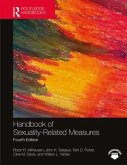- Broschiertes Buch
- Merkliste
- Auf die Merkliste
- Bewerten Bewerten
- Teilen
- Produkt teilen
- Produkterinnerung
- Produkterinnerung
Revised edition of the author's Sexuality, 2009.
Andere Kunden interessierten sich auch für
![Sexuality Sexuality]() Jeffrey WeeksSexuality24,99 €
Jeffrey WeeksSexuality24,99 €![Tomorrow Sex Will Be Good Again Tomorrow Sex Will Be Good Again]() Katherine AngelTomorrow Sex Will Be Good Again8,99 €
Katherine AngelTomorrow Sex Will Be Good Again8,99 €![Rough Rough]() Rachel ThompsonRough12,99 €
Rachel ThompsonRough12,99 €![The History of Sexuality: 1 The History of Sexuality: 1]() Michel FoucaultThe History of Sexuality: 19,99 €
Michel FoucaultThe History of Sexuality: 19,99 €![Handbook of Sexuality-Related Measures Handbook of Sexuality-Related Measures]() Handbook of Sexuality-Related Measures142,99 €
Handbook of Sexuality-Related Measures142,99 €![The History of Sexuality: 3 The History of Sexuality: 3]() Michel FoucaultThe History of Sexuality: 311,99 €
Michel FoucaultThe History of Sexuality: 311,99 €![Childhood Childhood]() Chris JenksChildhood181,99 €
Chris JenksChildhood181,99 €-
-
-
Revised edition of the author's Sexuality, 2009.
Hinweis: Dieser Artikel kann nur an eine deutsche Lieferadresse ausgeliefert werden.
Hinweis: Dieser Artikel kann nur an eine deutsche Lieferadresse ausgeliefert werden.
Produktdetails
- Produktdetails
- Key Ideas
- Verlag: Taylor & Francis Ltd
- 4 ed
- Seitenzahl: 282
- Erscheinungstermin: 15. September 2016
- Englisch
- Abmessung: 195mm x 128mm x 22mm
- Gewicht: 336g
- ISBN-13: 9781138022898
- ISBN-10: 1138022896
- Artikelnr.: 45311452
- Herstellerkennzeichnung
- Libri GmbH
- Europaallee 1
- 36244 Bad Hersfeld
- gpsr@libri.de
- Key Ideas
- Verlag: Taylor & Francis Ltd
- 4 ed
- Seitenzahl: 282
- Erscheinungstermin: 15. September 2016
- Englisch
- Abmessung: 195mm x 128mm x 22mm
- Gewicht: 336g
- ISBN-13: 9781138022898
- ISBN-10: 1138022896
- Artikelnr.: 45311452
- Herstellerkennzeichnung
- Libri GmbH
- Europaallee 1
- 36244 Bad Hersfeld
- gpsr@libri.de
Jeffrey Weeks is Emeritus Professor of Sociology at London South Bank University.
1. Introduction: Languages of Sex
1.1. The Significance of Sexuality
1.2. Words and Meaning
1.3. Sexualities in History and Society
2. The Invention of Sexuality
2.1. A Brief History of the History of Sexuality
2.2. A Subject in Constant Flux
2.3. The `Social Construction¿ of Sexuality
2.4. The Organization of Sexuality
2.5. Kinship and Family Systems
2.6. Economic and Social Organization
2.7. Social Regulation
2.8. Politics
2.9. Cultures of Resistance
2.10. Why Sexuality is Important
2.11. Moral Concern
2.12. Key Moments
2.13. The Homosexual Category and New Binaries
2.14. Sexuality as the Truth of our Being
2.15. Intersections
2.16. Sexuality and Power
2.17. Conflicting Dynamics
2.18. Class
2.19. Gender
2.20. Race
3. The Meanings of Sexual Difference
3.1. A True Sex?
3.2. The Biological Imperative
3.3. Evolutionary Diversions
3.4. Biological Modes of Argument
3.5. Sexuality and Social Relations
3.6. Multiple Realities and Diverse Social Worlds
3.7. Performing Identities
3.8. Sexuality and the Unconscious
3.9. Affect, and the Structuring of Emotions
3.10. Phobias and Norms
4. The Challenge of Diversity
4.1. The Language of Perversity
4.2. Two Words
4.3. The Perverse
4.4. Freud and Perversions
4.5. Categorizing Sexualities
4.6. The Discourse of Diversity
4.7. Theoretical Challenges
4.8. Sexual Minorities
4.9. Same-sex Identities
4.10. Finding Voice
4.11. Queering the Pitch
4.12. Deconstructing the Categories
4.13. Acts and Context
4.14. Heterosexuality and its Discontents
4.15. Bisexuality
4.16. The Transgender Challenge
4.17. The Play of Power: BDSM
4.18. The Limits of Consent: Paedophilia
4.19. Making Choices
5. Sexuality, Intimacy and Politics
5.1. Sexuality on the Front Line
5.2. Sexuality as a Battleground
5.3. Nostalgic Longings
5.4. Beyond Tradition
5.5. Secularization
5.6. Individualization
5.7. Liberalization and the Growth of Sexual Toleration
5.8. Cybersex
5.9. The Technological Fix
5.10. Relationality and the Intimate Revolution
5.11. Living with Uncertainty: HIV/AIDS
5.12. Moral Panics
5.13. Epidemic
5.14. The Global Impact of HIV/ AIDS
5.15. Sexual and Intimate Citizenship
5.16. Intimacy Matters
5.17. Citizenship and Belonging
5.18. Same Sex Marriage
5.19. Globalization and Human Sexual Rights
5.20. Global Flows
5.21. Sexual Wrongs and Social Justice
5.22. Human Sexual Rights
6. Private Pleasures and Public Policies
6.1. The Limits of Science
6.2. The Ethical Dilemma
6.3. Towards Sexual Democracy
6.4. The Human Gesture
Suggestions for Further Reading
Bibliography
1.1. The Significance of Sexuality
1.2. Words and Meaning
1.3. Sexualities in History and Society
2. The Invention of Sexuality
2.1. A Brief History of the History of Sexuality
2.2. A Subject in Constant Flux
2.3. The `Social Construction¿ of Sexuality
2.4. The Organization of Sexuality
2.5. Kinship and Family Systems
2.6. Economic and Social Organization
2.7. Social Regulation
2.8. Politics
2.9. Cultures of Resistance
2.10. Why Sexuality is Important
2.11. Moral Concern
2.12. Key Moments
2.13. The Homosexual Category and New Binaries
2.14. Sexuality as the Truth of our Being
2.15. Intersections
2.16. Sexuality and Power
2.17. Conflicting Dynamics
2.18. Class
2.19. Gender
2.20. Race
3. The Meanings of Sexual Difference
3.1. A True Sex?
3.2. The Biological Imperative
3.3. Evolutionary Diversions
3.4. Biological Modes of Argument
3.5. Sexuality and Social Relations
3.6. Multiple Realities and Diverse Social Worlds
3.7. Performing Identities
3.8. Sexuality and the Unconscious
3.9. Affect, and the Structuring of Emotions
3.10. Phobias and Norms
4. The Challenge of Diversity
4.1. The Language of Perversity
4.2. Two Words
4.3. The Perverse
4.4. Freud and Perversions
4.5. Categorizing Sexualities
4.6. The Discourse of Diversity
4.7. Theoretical Challenges
4.8. Sexual Minorities
4.9. Same-sex Identities
4.10. Finding Voice
4.11. Queering the Pitch
4.12. Deconstructing the Categories
4.13. Acts and Context
4.14. Heterosexuality and its Discontents
4.15. Bisexuality
4.16. The Transgender Challenge
4.17. The Play of Power: BDSM
4.18. The Limits of Consent: Paedophilia
4.19. Making Choices
5. Sexuality, Intimacy and Politics
5.1. Sexuality on the Front Line
5.2. Sexuality as a Battleground
5.3. Nostalgic Longings
5.4. Beyond Tradition
5.5. Secularization
5.6. Individualization
5.7. Liberalization and the Growth of Sexual Toleration
5.8. Cybersex
5.9. The Technological Fix
5.10. Relationality and the Intimate Revolution
5.11. Living with Uncertainty: HIV/AIDS
5.12. Moral Panics
5.13. Epidemic
5.14. The Global Impact of HIV/ AIDS
5.15. Sexual and Intimate Citizenship
5.16. Intimacy Matters
5.17. Citizenship and Belonging
5.18. Same Sex Marriage
5.19. Globalization and Human Sexual Rights
5.20. Global Flows
5.21. Sexual Wrongs and Social Justice
5.22. Human Sexual Rights
6. Private Pleasures and Public Policies
6.1. The Limits of Science
6.2. The Ethical Dilemma
6.3. Towards Sexual Democracy
6.4. The Human Gesture
Suggestions for Further Reading
Bibliography
1. Introduction: Languages of Sex
1.1. The Significance of Sexuality
1.2. Words and Meaning
1.3. Sexualities in History and Society
2. The Invention of Sexuality
2.1. A Brief History of the History of Sexuality
2.2. A Subject in Constant Flux
2.3. The `Social Construction¿ of Sexuality
2.4. The Organization of Sexuality
2.5. Kinship and Family Systems
2.6. Economic and Social Organization
2.7. Social Regulation
2.8. Politics
2.9. Cultures of Resistance
2.10. Why Sexuality is Important
2.11. Moral Concern
2.12. Key Moments
2.13. The Homosexual Category and New Binaries
2.14. Sexuality as the Truth of our Being
2.15. Intersections
2.16. Sexuality and Power
2.17. Conflicting Dynamics
2.18. Class
2.19. Gender
2.20. Race
3. The Meanings of Sexual Difference
3.1. A True Sex?
3.2. The Biological Imperative
3.3. Evolutionary Diversions
3.4. Biological Modes of Argument
3.5. Sexuality and Social Relations
3.6. Multiple Realities and Diverse Social Worlds
3.7. Performing Identities
3.8. Sexuality and the Unconscious
3.9. Affect, and the Structuring of Emotions
3.10. Phobias and Norms
4. The Challenge of Diversity
4.1. The Language of Perversity
4.2. Two Words
4.3. The Perverse
4.4. Freud and Perversions
4.5. Categorizing Sexualities
4.6. The Discourse of Diversity
4.7. Theoretical Challenges
4.8. Sexual Minorities
4.9. Same-sex Identities
4.10. Finding Voice
4.11. Queering the Pitch
4.12. Deconstructing the Categories
4.13. Acts and Context
4.14. Heterosexuality and its Discontents
4.15. Bisexuality
4.16. The Transgender Challenge
4.17. The Play of Power: BDSM
4.18. The Limits of Consent: Paedophilia
4.19. Making Choices
5. Sexuality, Intimacy and Politics
5.1. Sexuality on the Front Line
5.2. Sexuality as a Battleground
5.3. Nostalgic Longings
5.4. Beyond Tradition
5.5. Secularization
5.6. Individualization
5.7. Liberalization and the Growth of Sexual Toleration
5.8. Cybersex
5.9. The Technological Fix
5.10. Relationality and the Intimate Revolution
5.11. Living with Uncertainty: HIV/AIDS
5.12. Moral Panics
5.13. Epidemic
5.14. The Global Impact of HIV/ AIDS
5.15. Sexual and Intimate Citizenship
5.16. Intimacy Matters
5.17. Citizenship and Belonging
5.18. Same Sex Marriage
5.19. Globalization and Human Sexual Rights
5.20. Global Flows
5.21. Sexual Wrongs and Social Justice
5.22. Human Sexual Rights
6. Private Pleasures and Public Policies
6.1. The Limits of Science
6.2. The Ethical Dilemma
6.3. Towards Sexual Democracy
6.4. The Human Gesture
Suggestions for Further Reading
Bibliography
1.1. The Significance of Sexuality
1.2. Words and Meaning
1.3. Sexualities in History and Society
2. The Invention of Sexuality
2.1. A Brief History of the History of Sexuality
2.2. A Subject in Constant Flux
2.3. The `Social Construction¿ of Sexuality
2.4. The Organization of Sexuality
2.5. Kinship and Family Systems
2.6. Economic and Social Organization
2.7. Social Regulation
2.8. Politics
2.9. Cultures of Resistance
2.10. Why Sexuality is Important
2.11. Moral Concern
2.12. Key Moments
2.13. The Homosexual Category and New Binaries
2.14. Sexuality as the Truth of our Being
2.15. Intersections
2.16. Sexuality and Power
2.17. Conflicting Dynamics
2.18. Class
2.19. Gender
2.20. Race
3. The Meanings of Sexual Difference
3.1. A True Sex?
3.2. The Biological Imperative
3.3. Evolutionary Diversions
3.4. Biological Modes of Argument
3.5. Sexuality and Social Relations
3.6. Multiple Realities and Diverse Social Worlds
3.7. Performing Identities
3.8. Sexuality and the Unconscious
3.9. Affect, and the Structuring of Emotions
3.10. Phobias and Norms
4. The Challenge of Diversity
4.1. The Language of Perversity
4.2. Two Words
4.3. The Perverse
4.4. Freud and Perversions
4.5. Categorizing Sexualities
4.6. The Discourse of Diversity
4.7. Theoretical Challenges
4.8. Sexual Minorities
4.9. Same-sex Identities
4.10. Finding Voice
4.11. Queering the Pitch
4.12. Deconstructing the Categories
4.13. Acts and Context
4.14. Heterosexuality and its Discontents
4.15. Bisexuality
4.16. The Transgender Challenge
4.17. The Play of Power: BDSM
4.18. The Limits of Consent: Paedophilia
4.19. Making Choices
5. Sexuality, Intimacy and Politics
5.1. Sexuality on the Front Line
5.2. Sexuality as a Battleground
5.3. Nostalgic Longings
5.4. Beyond Tradition
5.5. Secularization
5.6. Individualization
5.7. Liberalization and the Growth of Sexual Toleration
5.8. Cybersex
5.9. The Technological Fix
5.10. Relationality and the Intimate Revolution
5.11. Living with Uncertainty: HIV/AIDS
5.12. Moral Panics
5.13. Epidemic
5.14. The Global Impact of HIV/ AIDS
5.15. Sexual and Intimate Citizenship
5.16. Intimacy Matters
5.17. Citizenship and Belonging
5.18. Same Sex Marriage
5.19. Globalization and Human Sexual Rights
5.20. Global Flows
5.21. Sexual Wrongs and Social Justice
5.22. Human Sexual Rights
6. Private Pleasures and Public Policies
6.1. The Limits of Science
6.2. The Ethical Dilemma
6.3. Towards Sexual Democracy
6.4. The Human Gesture
Suggestions for Further Reading
Bibliography








